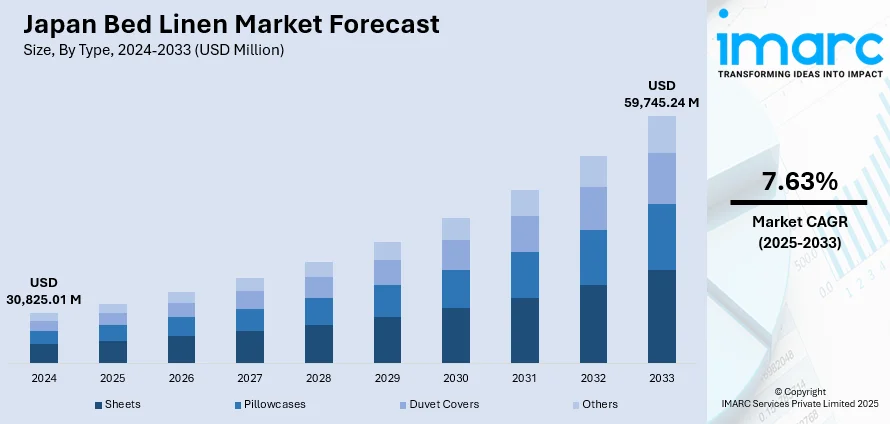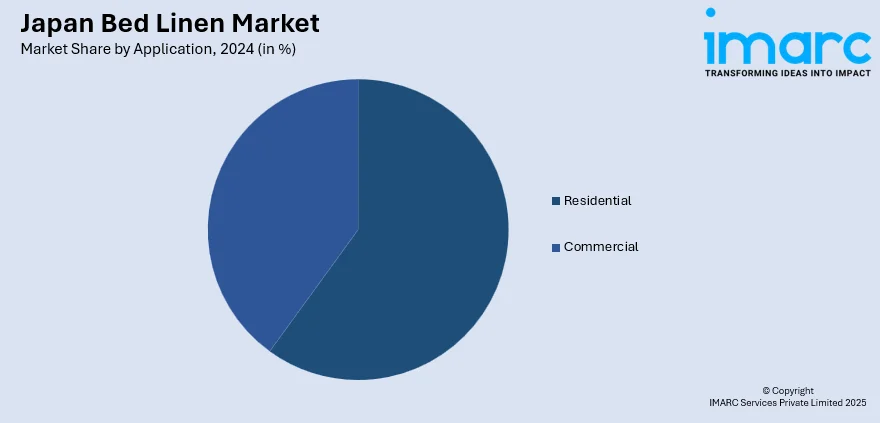
Japan Bed Linen Market Size, Share, Trends and Forecast by Type, Application, Distribution Channel, and Region, 2025-2033
Japan Bed Linen Market Overview:
The Japan bed linen market size reached USD 30,825.01 Million in 2024. Looking forward, IMARC Group expects the market to reach USD 59,745.24 Million by 2033, exhibiting a growth rate (CAGR) of 7.63% during 2025-2033. The market is driven by increasing consumer preference for high-quality, comfortable, and hypoallergenic bedding, supported by a growing aging population seeking better sleep solutions. Rising awareness of interior aesthetics, coupled with the influence of Western lifestyle trends, is fueling demand for premium, stylish, and coordinated bed linen products. Additionally, advancements in fabric technology, sustainability initiatives, and the expansion of e-commerce platforms are further accelerating Japan bed linen market share.
|
Report Attribute
|
Key Statistics
|
|---|---|
|
Base Year
|
2024 |
|
Forecast Years
|
2025-2033
|
|
Historical Years
|
2019-2024
|
| Market Size in 2024 | USD 30,825.01 Million |
| Market Forecast in 2033 | USD 59,745.24 Million |
| Market Growth Rate 2025-2033 | 7.63% |
Japan Bed Linen Market Trends:
Aging Population and Its Impact on Bed Linen Preferences
The aging population of the country is a major driver influencing the market trends. Industry reports indicate that the elderly population in the country has reached an all-time high of 36.25 million, with individuals aged 65 and above constituting approximately one-third of the population. With the percentage of older adults in Japan increasing every year, there is a growing need for bedding products that meet the unique needs of this age group. Aging consumers value comfort and simplicity of use in their bedding, which affects product development. Consequently, the demand is increasing for bed linens that are soft, skin-friendly, and easy to manage. Fabrics like cotton, which is hypoallergenic and breathable, are in greater demand. Furthermore, older adults are seeking beddings that provide functional advantages such as fall prevention through anti-slip properties, or easier-to-manage materials, particularly for those with declining strength or mobility. The requirements of the elderly population are further propelling industries to develop items offering better comfort and sleep quality, thereby focusing on the peculiar needs of the demographic.

Increasing Urbanization and Smaller Living Spaces
Rapid urbanization in Japan, especially in the larger cities such as Tokyo and Osaka, is leading to reduced living spaces, which is impacting the market. Japanese consumers want compact, multifunctional beddings that ensure maximum use of space without compromise on comfort due to the limited living space in many urban residences. This is increasing demand for lighter, foldable, and space-efficient bedding products. Consumers are also seeking fashionable but functional bed linens that can match contemporary, minimalist interior decor. Besides this, storage-friendly bedding products like roll-up beddings or easily packable bedding sets are gaining popularity. This, in turn, is providing an impetus to the Japan bed linen market growth. Since more individuals are residing in apartments, there is an increasing need for bed linen products that offer flexibility and space-saving, which is fueling product innovation and functionality.
Sustainability and Eco-Friendly Trends
Sustainability has become a rising concern that is shaping Japanese consumers' buying behavior in the market. There is greater demand for environmentally friendly bedding products produced from organic and sustainable materials such as bamboo, organic cotton, and recycled fabrics. Apart from this, consumers are looking for products that resonate with their values and environmental standpoint, opting for those produced through environmentally friendly processes, including natural dyeing processes and low use of toxic chemicals. Certifications are becoming increasingly significant as they guarantee the product's environmental and social standards. This shift towards sustainability is also driving innovations in the manufacture of more environmentally friendly bedding that is functional as well as environmentally beneficial. The demand for greener, more sustainable products will increase, with consumers increasingly seeking long-term environmental consideration over short-term product fashion.
Japan Bed Linen Market Segmentation:
IMARC Group provides an analysis of the key trends in each segment of the market, along with forecasts at the country and regional levels for 2025-2033. Our report has categorized the market based on type, application, and distribution channel.
Type Insights:
- Sheets
- Pillowcases
- Duvet Covers
- Others
The report has provided a detailed breakup and analysis of the market based on the type. This includes sheets, pillowcases, duvet covers, and others.
Application Insights:

- Residential
- Commercial
A detailed breakup and analysis of the market based on the application have also been provided in the report. This includes residential and commercial.
Distribution Channel Insights:
- Online
- Offline
The report has provided a detailed breakup and analysis of the market based on the distribution channel. This includes online and offline.
Regional Insights:
- Kanto Region
- Kansai/Kinki Region
- Central /Chubu Region
- Kyushu-Okinawa Region
- Tohoku Region
- Chugoku Region
- Hokkaido Region
- Shikoku Region
The report has also provided a comprehensive analysis of all the major regional markets, which include Kanto Region, Kansai/Kinki Region, Central /Chubu Region, Kyushu-Okinawa Region, Tohoku Region, Chugoku Region, Hokkaido Region, and Shikoku Region.
Competitive Landscape:
The market research report has also provided a comprehensive analysis of the competitive landscape. Competitive analysis such as market structure, key player positioning, top winning strategies, competitive dashboard, and company evaluation quadrant has been covered in the report. Also, detailed profiles of all major companies have been provided.
Japan Bed Linen Market News:
- On March 15, 2023, Toyoshima & Co., Ltd. launched a limited-time collection of bedding items, duvet covers, box sheets, and pillowcases, crafted from its traceable organic cotton brand, TRUECOTTON, under the supervision of lifestyle influencer Mari Ishioka. The collection, designed with skin-friendly double gauze fabric and practical features like double zippers. This initiative underscores Toyoshima's commitment to sustainable production, ethical sourcing, and promoting environmentally responsible consumer choices.
- On May 12, 2025, Taiwan-based bedding brand SleepyTofu inaugurated its first Japanese flagship store, SLEEPY TOFU HOUSE, in Minami-Aoyama, Tokyo. The store offers popular products such as the "Sleepy Tofu" and "Sleepy Inari" mattresses, along with pillows, comforters, and fitted pads, all within a home-like setting designed to engage the senses. Featuring a tofu-themed children's area and seasonal Taiwanese tea service, the store aims to provide a relaxing, immersive experience that blends Taiwanese and Japanese cultural elements.
Japan Bed Linen Market Report Coverage:
| Report Features | Details |
|---|---|
| Base Year of the Analysis | 2024 |
| Historical Period | 2019-2024 |
| Forecast Period | 2025-2033 |
| Units | Million USD |
| Scope of the Report |
Exploration of Historical Trends and Market Outlook, Industry Catalysts and Challenges, Segment-Wise Historical and Future Market Assessment:
|
| Types Covered | Sheets, Pillowcases, Duvet Covers, Others |
| Applications Covered | Residential, Commercial |
| Distribution Channels Covered | Online, Offline |
| Regions Covered | Kanto Region, Kansai/Kinki Region, Central /Chubu Region, Kyushu-Okinawa Region, Tohoku Region, Chugoku Region, Hokkaido Region, Shikoku Region |
| Customization Scope | 10% Free Customization |
| Post-Sale Analyst Support | 10-12 Weeks |
| Delivery Format | PDF and Excel through Email (We can also provide the editable version of the report in PPT/Word format on special request) |
Key Questions Answered in This Report:
- How has the Japan bed linen market performed so far and how will it perform in the coming years?
- What is the breakup of the Japan bed linen market on the basis of type?
- What is the breakup of the Japan bed linen market on the basis of application?
- What is the breakup of the Japan bed linen market on the basis of distribution channel?
- What is the breakup of the Japan bed linen market on the basis of region?
- What are the various stages in the value chain of the Japan bed linen market?
- What are the key driving factors and challenges in the Japan bed linen market?
- What is the structure of the Japan bed linen market and who are the key players?
- What is the degree of competition in the Japan bed linen market?
Key Benefits for Stakeholders:
- IMARC’s industry report offers a comprehensive quantitative analysis of various market segments, historical and current market trends, market forecasts, and dynamics of the Japan bed linen market from 2019-2033.
- The research report provides the latest information on the market drivers, challenges, and opportunities in the Japan bed linen market.
- Porter's five forces analysis assist stakeholders in assessing the impact of new entrants, competitive rivalry, supplier power, buyer power, and the threat of substitution. It helps stakeholders to analyze the level of competition within the Japan bed linen industry and its attractiveness.
- Competitive landscape allows stakeholders to understand their competitive environment and provides an insight into the current positions of key players in the market.
Need more help?
- Speak to our experienced analysts for insights on the current market scenarios.
- Include additional segments and countries to customize the report as per your requirement.
- Gain an unparalleled competitive advantage in your domain by understanding how to utilize the report and positively impacting your operations and revenue.
- For further assistance, please connect with our analysts.
 Request Customization
Request Customization
 Speak to an Analyst
Speak to an Analyst
 Request Brochure
Request Brochure
 Inquire Before Buying
Inquire Before Buying




.webp)




.webp)












